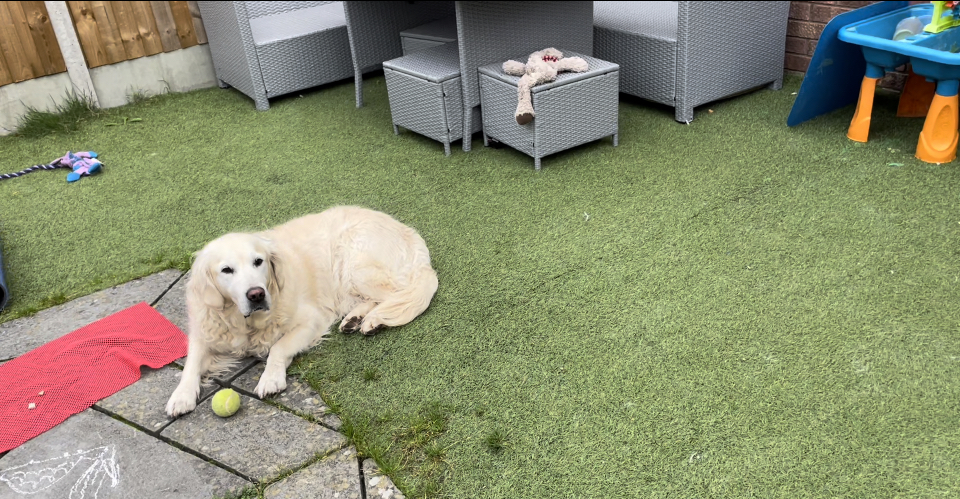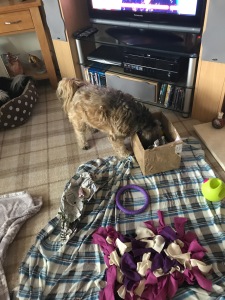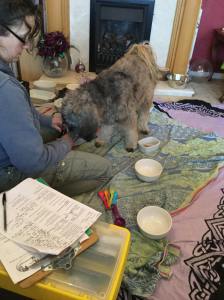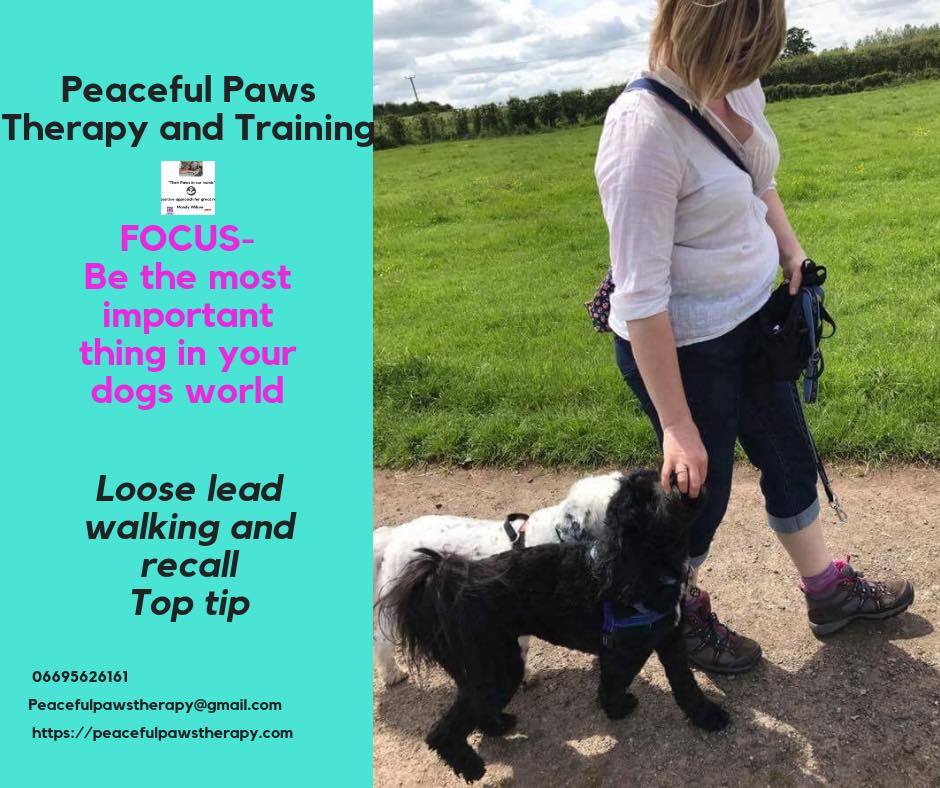This is Tilly. She is an 8-year-old Retriever. She has had reactive responses to some dogs, especially when taken by surprise or when she can’t create space, since she was attacked as a young dog. Her family have managed for the past while but after an event at home out of the blue they asked for help. Tillys mum chose Peaceful Paws because we look at the needs holistically, considering every aspect that might impact her need to respond with a growl to an unexpected approach.

Tilly is a calm and happy dog; her one-off response was out of character. Our first place to investigate is pain and health, including nutrition, gut, water, sleep etc. As she is older, we expect some joint stiffness, but there is no obvious pain according to her Vet. Her approach to food is unusual, as is her response to us rewarding behaviours in general, she is disinterested. We looked at some high value food and favourite toys and she just wasn’t interested. However, interaction with her Mum was her highest reward.
We set up some Freework to explore this further. To see if free access to a wide range of food and toys without any pressure or expectation might have a different response. We were gathering information. She browsed, had a lick of cheese and some ham but ignored at other passes. she ignored her favourite toys. There was no concern about movement or her choice of surfaces. She did however grab a ball and take herself off, seemingly to process this unusual experience, she seemed to gain some comfort with the ball and then drop it and re-engage.
What we did notice was her constant look back to her mum for permission and reassurance. She regularly referred back. She found making her own choices hard. We also discovered her Mum has an aversion to meat. The response is visceral. It raised a question, with Tillys very close relationship was she gathering information from her Mum about the safety or appropriateness of their shared experiences? Over the next couple of weeks, they worked on more freework and adding in activities to support Tilly to gain confidence in her own independence. They also worked on some focus games with the attention from Mum as the reward, including some ball fun, Tilly has still used balls as a comfort, it was noted that her unfortunate event at home was related to a ball.
Next, we unpacked her reactive responses more. We wanted to gain information around the days around the unfortunate home event, including any events with dogs locally and the outcomes on both Mum and Tilly. This is where Tillys humans began to learn more about her needs and the communications she has been unable to make heard. We explored what might have been “Filling her Stress and Arousal Bucket”. This is an analogy which enables us to explore all the events and feelings Tilly may have had which contribute to the accumulation of stress and any lovely events which might empty it (as well as lovely busy things that add to it!). The Tricky moments or discomfort or worry, including worry about her mum, add to her bucket. She has a reduced capacity for independent management of self-confidence and so her capacity to manage the load is reduced. She has a lovely quiet loved life, and this will definitely help empty it sometimes. She loves ball fun; this will fill a little with fun arousal. Find out more about Buckets https://absolute-dogs.com/massively-improve-your-dogs-behaviour-lifespan-and-health-without-pharmaceuticals/?fbclid=IwAR2t2OfdOlgfgOGAfw3tu8TSPhDpHWrTfQy6Wo743uSvI0VwtxBg8F5ao4U
We looked at how many events, and what they looked like, she has roughly in a week and her Mum quickly saw how this could impact her feelings of control and safety. Once she understood what life was like for Tilly on the walk she believed she should have twice a day, setting up a plan was so much easier to understand.
During our explorations we also looked at how Mum felt about Tilly and the reactive events. This was our breakthrough. When we added Mums Stress Bucket too and considered Tillys reliance on her mum for support, safety and confidence as well as what to do, now Mum could see that they were both struggling with the worry of the encounters twice a day. Mum was really reluctant to get out and face what would inevitably be stressful. She started the walk in trepidation.
So, in Session 2/5 we started to work on their Buckets. None of the usual Modification and protocol activities had yet been undertaken, we focussed on the WHOLEism of the needs of the whole family, their lifestyle emotional and physical wellness, their environments, their relationships, not just on the behaviours we were seeing.
Without this knowledge any structured behaviour modification work might be unsuccessful, until Mum feels more confident Tilly wont, she can’t be “coerced ” into working to manage her responses to the dogs she sees with food or games as her highest value is her interaction with Mum (who was struggling too).
They cut right down how often they put themselves through the pressure of a street walk encounter. They are lucky to have a field to use and that is what they did. They also played some focus games with balls and attention as the rewards and engagement focus. This, alongside the emptying of the Walk Stress Bucket, swapped their high cortisol impact on Nervous system also impacting their mental and physical wellbeing, for high dopamine and serotonin happy hormones which in turn impacted their outlooks and with Tilly more interest in food too.
In 3/5 session Mum was much more positive, she had been reframing her approach to the world with Tilly beyond home. She was aware of how her own behaviours are impacting Tillys ability to make decisions and choices and how Tillys confidence relies on her own. She has been working on her own mindset. This is now a deeper focus for her as we venture into the world again.
Our next steps was to start the positivity to the outside world BEFORE we left! Mum spent some time whilst she got ready for the walk thinking about what her happy walk will look like. The weather, the environment, her own good feelings. We also changed Tillys walk equipment. She had been walked on a collar which adds to the fear when there is neck pressure and her lead kept short, reducing her chance make or indicate her wish to make choices about where she will go. She has a perfect fit 2 point of contact harness, fitted by a physio. She also has a double end lead which attaches both at the front and back. The lead, even double clipped, is longer than her previous one. This change in handling was at first a little different for Tilly and she took a few minutes to find her improved balance.
Her Mum however, quickly found her improved handling. We started with her own body and mind, standing up, balanced and loose is empowering. it feels more confident. The relaxation of the shoulders and loose holding of the lead helped her to feel mentally relaxed. We chatted as we moved and she was encouraged to converse positively with Tilly as they walked, to share directions and ask for choices, but also to share the observations she was making of the environment. she was mindful of the speed of her movement and as we slowed so did Tilly, who took more time to sniff and mark. This slowed her busy mind enabling her to see more of what was around her, Mum noticed this too, she commented that usually she just focussed on getting home as soon as she had left home so marched to get it overwith.
We spent some coaching time on a loose relaxed handling, so the lead was loose and had some space for Tilly to make decisions where to sniff and when asked some space to make direction choices. What we did also notice was that Tilly was referring to Mum much less, this raised the question, was she more confident, or was she disconnected because she could not rely on her safe haven in this situation? Ideally, we want a balance. Tilly should be encouraged to be confident to explore her world and make good choices, but also, she needs to be connected when they have shared decisions to make or when Mum becomes the Safe Haven with active decision making.
We then began for the first time to add in activities to develop a shared decision-making relationship and to gain more focus from Tilly to her Mum.
Our first game was one to play every now and then, on lead and off lead. “Let’s Go” (or A-B) helps to develop a cheery way to make space and to enable them to make a decision about what next. We played it on different times on our walk so the game was not a predictor of space making for a dog event. This was for Mum too, so she also had a fun and calm emotion attached to the game. A cheery “Let’s go” and a run or quick move to another place, backwards, sidewards, behind a car or wall or down to the river. Mum learned a handling technique which was confident, and one Tilly was happy to respond to which also added a change in the way the lead handled so it is a body cue too. We now need to teach Tilly some short fun activities to play together when they get “there”. This is sometimes just some balls to find (ordinarily it might be a food to seek). For Tilly (and many dogs) the focus relationship time is rewarding, and it builds a routine which is familiar.
Mum went home buoyant, the walk was the most fun and relaxing time they had out together in a long, long time. She is changing her mindset and growing some skills to add to their toolbox which is raising her self-confidence and, as they are so bonded, that is rubbing off on Tilly.
Our next steps are to learn some more fun games to use to create a confident mindset together. Tilly may never be totally keen on dogs inside her chosen bubble, but that’s OK, her mum has a goal of them feeling better about walking together, to enjoy their environment and be realistic about what happens when there is an encounter. She knows how to be Tillys Safe Haven and how to help her when times are tricky. They are well on their way to achieve that.
If you would like to know more about a WHOLEistic approach to behaviour and training please get in touch, Tillys story is one of many!







